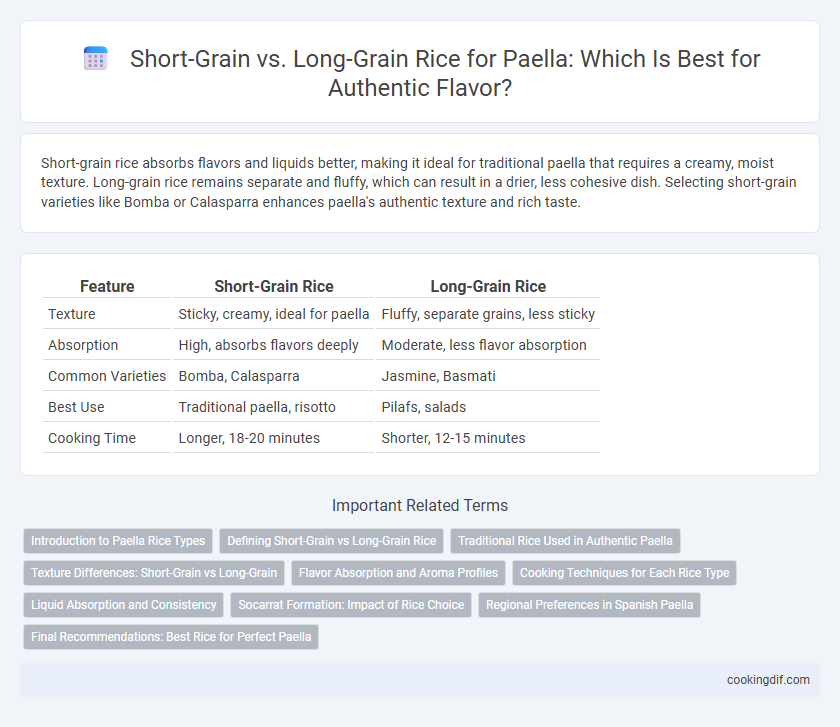Short-grain rice absorbs flavors and liquids better, making it ideal for traditional paella that requires a creamy, moist texture. Long-grain rice remains separate and fluffy, which can result in a drier, less cohesive dish. Selecting short-grain varieties like Bomba or Calasparra enhances paella's authentic texture and rich taste.
Table of Comparison
| Feature | Short-Grain Rice | Long-Grain Rice |
|---|---|---|
| Texture | Sticky, creamy, ideal for paella | Fluffy, separate grains, less sticky |
| Absorption | High, absorbs flavors deeply | Moderate, less flavor absorption |
| Common Varieties | Bomba, Calasparra | Jasmine, Basmati |
| Best Use | Traditional paella, risotto | Pilafs, salads |
| Cooking Time | Longer, 18-20 minutes | Shorter, 12-15 minutes |
Introduction to Paella Rice Types
Paella traditionally uses short-grain rice varieties such as Bomba or Calasparra, prized for their exceptional ability to absorb liquid and flavors without becoming mushy. Long-grain rice, while common in other dishes, tends to remain separate and less creamy, making it less ideal for authentic paella textures. Selecting the right short-grain rice is crucial for achieving the signature moist yet firm consistency characteristic of classic Spanish paella.
Defining Short-Grain vs Long-Grain Rice
Short-grain rice is plump and almost round, known for its high starch content that creates a creamy, sticky texture ideal for traditional paella. Long-grain rice is slender and firm, with lower starch content that results in a drier, separate grain ideal for pilafs. In paella, short-grain varieties like Bomba or Calasparra absorb liquid evenly and maintain texture, making them the preferred choice over long-grain rice.
Traditional Rice Used in Authentic Paella
Traditional authentic paella relies on short-grain varieties such as Bomba or Calasparra rice, prized for their ability to absorb flavors while maintaining a firm texture. Unlike long-grain rice, these short-grain types swell during cooking, absorbing broth evenly without becoming mushy. This characteristic is essential for achieving the signature socarrat, the crispy bottom layer crucial to traditional Valencian paella.
Texture Differences: Short-Grain vs Long-Grain
Short-grain rice, such as Bomba or Calasparra, absorbs liquid more efficiently and releases starch, creating a creamy and tender texture ideal for traditional paella. Long-grain rice varieties like Jasmine or Basmati retain firmness and separate grains, resulting in a fluffier texture that lacks the characteristic creaminess. The starch content in short-grain rice is crucial for achieving the desired moist, yet slightly al dente consistency that defines authentic paella.
Flavor Absorption and Aroma Profiles
Short-grain rice varieties like Bomba excel in paella due to their exceptional flavor absorption and ability to release a creamy texture without becoming mushy. Long-grain rice tends to retain its shape better but absorbs less broth, resulting in a less intense aroma and flavor profile. The unique starch composition of short-grain rice enhances the richness and depth of paella's signature saffron and seafood aromas.
Cooking Techniques for Each Rice Type
Short-grain rice, such as Bomba, absorbs liquid gradually, making it ideal for traditional paella where constant simmering and slow absorption develop a creamy texture without becoming mushy. Long-grain rice requires precise control of liquid and heat to prevent dryness or excessive stickiness, often benefiting from an initial saute and quick simmer to preserve separate, fluffy grains. Mastering these cooking techniques ensures the perfect balance between texture and flavor unique to each rice type in authentic paella recipes.
Liquid Absorption and Consistency
Short-grain rice varieties like Bomba and Calasparra absorb liquid more slowly and retain a firmer texture, ideal for achieving the creamy consistency of traditional paella. Long-grain rice tends to absorb liquid quickly but can become mushy, making it less suitable for maintaining the distinct grains and texture characteristic of authentic paella. Proper liquid absorption in short-grain rice ensures balanced moisture retention and a satisfying mouthfeel essential for classic paella dishes.
Socarrat Formation: Impact of Rice Choice
Short-grain rice varieties, such as Bomba or Calasparra, excel in paella by absorbing more liquid and flavor while maintaining firmness, crucial for achieving the prized socarrat crust. Long-grain rice tends to release starch differently, often resulting in a less cohesive bottom layer and a weaker socarrat formation. Optimal socarrat development depends on rice ability to absorb broth evenly and caramelize at the pan's base, where short-grain rice outperforms long-grain in texture and flavor concentration.
Regional Preferences in Spanish Paella
Short-grain rice, especially Bomba and Calasparra varieties, is preferred in Valencia and other eastern Spanish regions for paella due to its superior absorption and ability to remain firm without becoming mushy. Long-grain rice is less common in traditional paella but can be found in some modern adaptations outside Spain, favoring looser, drier textures. The regional emphasis on short-grain rice in Spain ensures authentic paella flavors and textures, highlighting the dish's culinary heritage.
Final Recommendations: Best Rice for Perfect Paella
Short-grain rice such as Bomba or Calasparra is ideal for making authentic paella due to its exceptional absorption and ability to remain firm without becoming mushy. Long-grain rice varieties tend to release more starch, resulting in a less distinct texture and a less traditional socarrat crust. For perfect paella, prioritize short-grain rice to achieve the ideal balance of creaminess and grain separation, ensuring an authentic flavor and texture.
Short-grain vs Long-grain for paella Infographic

 cookingdif.com
cookingdif.com